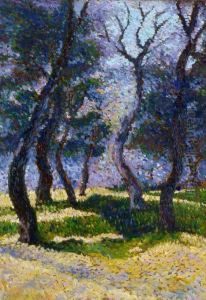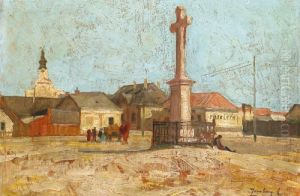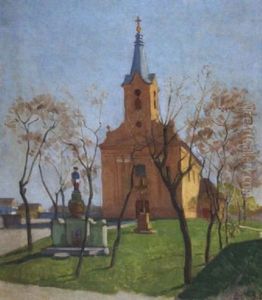Lajos Zombory Paintings
Lajos Zombory, a Hungarian painter and graphic artist, was born in 1883 in Munkács, then part of the Austro-Hungarian Empire and now known as Mukachevo in Ukraine. Zombory's artistic journey began at a young age, showing early promise in the arts. He pursued his passion for painting by studying at prestigious art schools, including the Hungarian College of Fine Arts in Budapest, where he was influenced by the prevailing styles of the late 19th and early 20th centuries. His style, characterized by its vivid realism and sensitivity to light and color, also showed elements of Impressionism, a movement he embraced after being exposed to its techniques and philosophies during his studies and travels in Western Europe.
Zombory's work captured a variety of subjects, from the serene landscapes of his homeland to the bustling life of its urban centers. He had a particular talent for portraiture, capturing the essence of his subjects with a remarkable depth of emotion and realism. Despite his ability to depict the beauty of the world around him, Zombory's career was interrupted by the outbreak of World War I. He served in the Austro-Hungarian Army, and his experiences during the war deeply impacted him, both personally and artistically. After the war, his work reflected a change, showing a more somber and reflective tone, with themes of loss and recovery becoming prevalent.
Throughout the interwar period, Zombory continued to paint and exhibit his work, gaining recognition within Hungary and abroad. His contributions to Hungarian art were significant, as he not only captured the beauty and complexity of his country's landscape and people but also its changing social and political landscapes. Despite the challenges he faced, including the turbulent times of World War II and the subsequent changes in Hungary's political system, Zombory remained dedicated to his art until his death in 1957.
Lajos Zombory's legacy is preserved through his paintings, which remain a testament to his skill, vision, and the profound impact of his experiences. His works are held in several Hungarian museums and collections, where they continue to be celebrated for their beauty, depth, and historical significance. Zombory's life and art offer a unique window into the soul of Hungary during a period of great change, making him a pivotal figure in the country's artistic heritage.


















